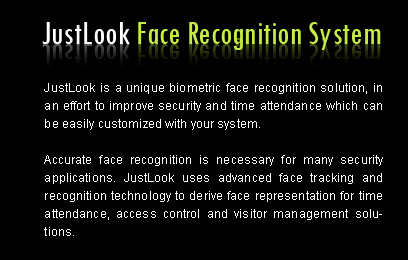System
Features
Simultaneous multiple face processing. Our biometric face recognition system performs fast and accurate detection of multiple faces in live video streams and still images. All faces on the current frame are detected in 0.07 sec. and then each face is processed in 0.13 sec.
Live face detection. A conventional face identification system can be easily cheated by placing a photo of another person in front of a camera. Our face recognition system is able to prevent this kind of security breach by determining whether a face in a video stream belongs to a real human or is a photo.
Face image quality determination. A quality threshold can be used during face enrolment to ensure that only the best quality face template will be stored into database.
Tolerance to face posture. Our face recognition system has certain tolerance to face posture that assures face enrolment convenience: rotation of a head can be up to 10 degrees from frontal in each direction (nodded up/down, rotated left/right, tilted left/right).
Multiple samples of the same face. Biometric template record can contain multiple face samples belonging to the same person. These samples can be enrolled with different face postures and expressions, from different sources and in different time thus allowing to improve matching quality.
Identification capability. Our system functions can be used in 1-to-1 matching (verification), as well as 1-to-many mode (identification).
Fast face matching. The JUSTLOOK 3.2 face template matching algorithm compares 100,000 faces per second.
Compact face features template. A face features template occupies only 2.3 Kilobytes, thus our applications can handle large face databases.
Features generalization mode. This mode generates the collection of the generalized face features from several images of the same subject. Then, each face image is processed, features are extracted, and the collections of features are analyzed and combined into a single generalized features collection, which is written to the database. This way, the enrolled feature template is more reliable and the face recognition quality increases considerably.
Live face detection. A conventional face identification system can be easily cheated by placing a photo of another person in front of a camera. Our face recognition system is able to prevent this kind of security breach by determining whether a face in a video stream belongs to a real human or is a photo.
Face image quality determination. A quality threshold can be used during face enrolment to ensure that only the best quality face template will be stored into database.
Tolerance to face posture. Our face recognition system has certain tolerance to face posture that assures face enrolment convenience: rotation of a head can be up to 10 degrees from frontal in each direction (nodded up/down, rotated left/right, tilted left/right).
Multiple samples of the same face. Biometric template record can contain multiple face samples belonging to the same person. These samples can be enrolled with different face postures and expressions, from different sources and in different time thus allowing to improve matching quality.
Identification capability. Our system functions can be used in 1-to-1 matching (verification), as well as 1-to-many mode (identification).
Fast face matching. The JUSTLOOK 3.2 face template matching algorithm compares 100,000 faces per second.
Compact face features template. A face features template occupies only 2.3 Kilobytes, thus our applications can handle large face databases.
Features generalization mode. This mode generates the collection of the generalized face features from several images of the same subject. Then, each face image is processed, features are extracted, and the collections of features are analyzed and combined into a single generalized features collection, which is written to the database. This way, the enrolled feature template is more reliable and the face recognition quality increases considerably.




